英语介词中时间介词的用法
in、on、at关于时间用法
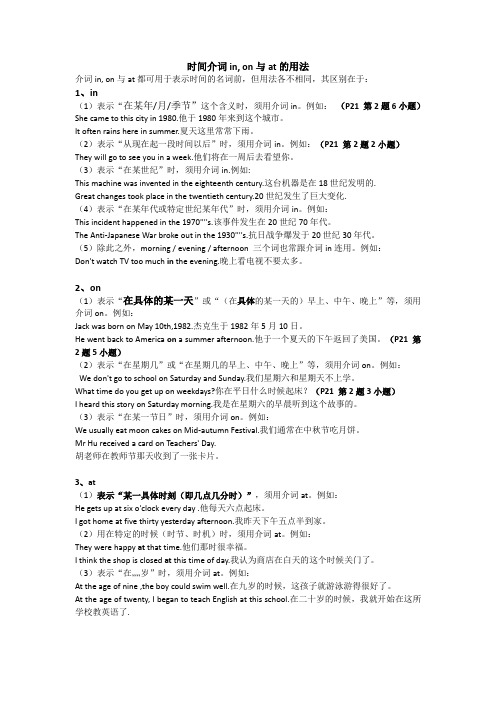
时间介词in, on与at的用法介词in, on与at都可用于表示时间的名词前,但用法各不相同,其区别在于:1、in(1)表示“在某年/月/季节”这个含义时,须用介词in。
例如:(P21 第2题6小题)She came to this city in 1980.他于1980年来到这个城市。
It often rains here in summer.夏天这里常常下雨。
(2)表示“从现在起一段时间以后”时,须用介词in。
例如:(P21 第2题2小题)They will go to see you in a week.他们将在一周后去看望你。
(3)表示“在某世纪”时,须用介词in.例如:This machine was invented in the eighteenth century.这台机器是在18世纪发明的.Great changes took place in the twentieth century.20世纪发生了巨大变化.(4)表示“在某年代或特定世纪某年代”时,须用介词in。
例如:This incident happened in the 1970''''s.该事件发生在20世纪70年代。
The Anti-Japanese War broke out in the 1930''''s.抗日战争爆发于20世纪30年代。
(5)除此之外,morning / evening / afternoon 三个词也常跟介词in连用。
例如:Don't watch TV too much in the evening.晚上看电视不要太多。
2、on(1)表示“在具体的某一天”或“(在具体的某一天的)早上、中午、晚上”等,须用介词on。
例如:Jack was born on May 10th,1982.杰克生于1982年5月10日。
He went back to America on a summer afternoon.他于一个夏天的下午返回了美国。
英语介词中时间介词的用法
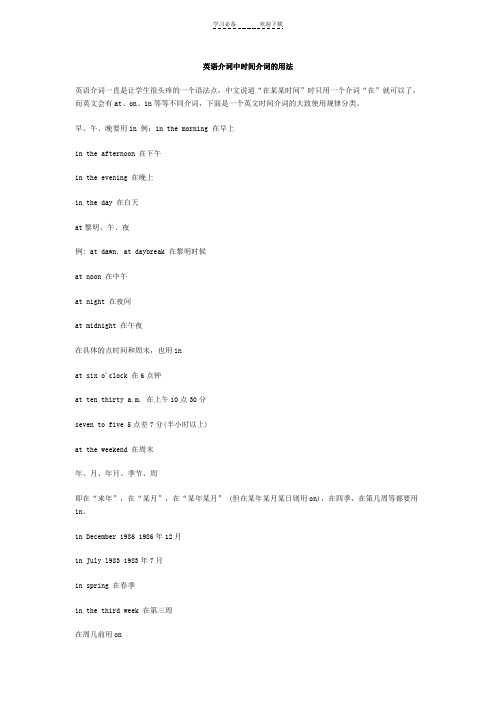
英语介词中时间介词的用法
英语介词一直是让学生很头疼的一个语法点,中文说道“在某某时间”时只用一个介词“在”就可以了,而英文会有at、on、in等等不同介词,下面是一个英文时间介词的大致使用规律分类。
早、午、晚要用in 例:in the morning 在早上
in the afternoon 在下午
in the evening 在晚上
in the day 在白天
at黎明、午、夜
例: at dawn, at daybreak 在黎明时候
at noon 在中午
at night 在夜间
at midnight 在午夜
在具体的点时间和周末,也用in
at six o'clock 在6点钟
at ten thirty a.m. 在上午10点30分
seven to five 5点差7分(半小时以上)
at the weekend 在周末
年、月、年月、季节、周
即在“来年”,在“某月”,在“某年某月” (但在某年某月某日则用on),在四季,在第几周等都要用in。
in December 1986 1986年12月
in July l983 1983年7月
in spring 在春季
in the third week 在第三周
在周几前用on
on Monday
on Sunday
周几和早、中、晚连用是是遵循“就近原则”(就是以第一个词为主)用on on Monday morning
on Sunday evening。
介词in-on-at在表示时间时的用法
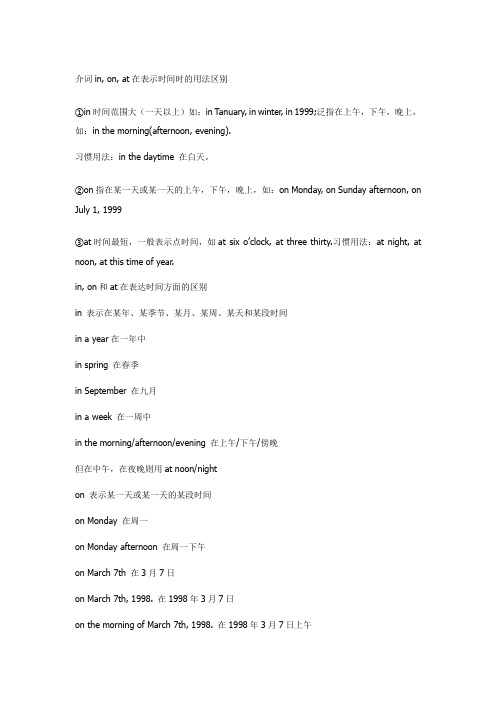
介词in, on, at在表示时间时的用法区别①in时间范围大(一天以上)如:in Tanuary, in winter, in 1999;泛指在上午,下午,晚上,如:in the morning(afternoon, evening).习惯用法:in the daytime 在白天。
②on指在某一天或某一天的上午,下午,晚上,如:on Monday, on Sunday afternoon, on July 1, 1999③at时间最短,一般表示点时间,如at six o’clock, at three thirty.习惯用法:at night, at noon, at this time of year.in, on和at在表达时间方面的区别in 表示在某年、某季节、某月、某周、某天和某段时间in a year在一年中in spring 在春季in September 在九月in a week 在一周中in the morning/afternoon/evening 在上午/下午/傍晚但在中午,在夜晚则用at noon/nighton 表示某一天或某一天的某段时间on Monday 在周一on Monday afternoon 在周一下午on March 7th 在3月7日on March 7th, 1998. 在1998年3月7日on the morning of March 7th, 1998. 在1998年3月7日上午at 表示某个具体时刻。
at eight o’clock 在8点钟at this time of the year 在一年中的这个时候at the moment 在那一时刻at that time 在那时注意:在英语中,如果时间名词前用this, last, next 等修饰时,像这样的表示,“在某时”的时间短语前,并不需要任何介词。
例如:last month, last week, this year, this week, next year, the next day, the next year 等。
全面、清晰的in、on、at的时间用法和地点用法
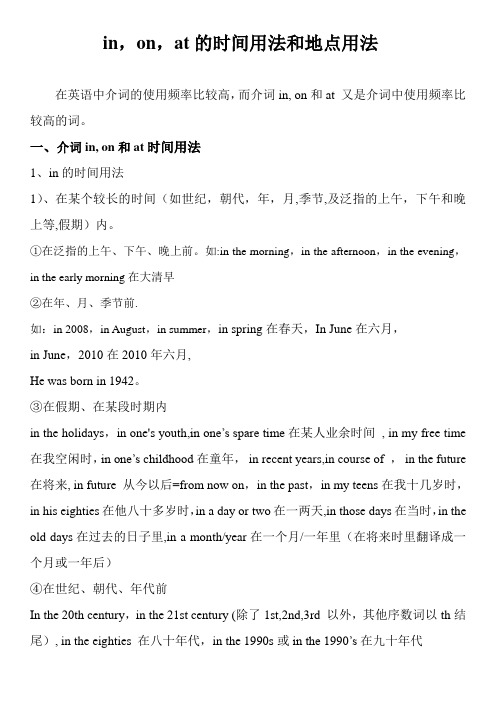
in,on,at的时间用法和地点用法在英语中介词的使用频率比较高,而介词in, on和at 又是介词中使用频率比较高的词。
一、介词in, on和at时间用法1、in的时间用法1)、在某个较长的时间(如世纪,朝代,年,月,季节,及泛指的上午,下午和晚上等,假期)内。
①在泛指的上午、下午、晚上前。
如:in the morning,in the afternoon,in the evening,in the early morning在大清早②在年、月、季节前.如:in 2008,in August,in summer,in spring在春天,In June在六月,in June,2010在2010年六月,He was born in 1942。
③在假期、在某段时期内in the holidays,in one's youth,in one’s spare time在某人业余时间, in my free time 在我空闲时,in one’s childhood在童年,in recent years,in course of ,in the future 在将来, in future 从今以后=from now on,in the past,in my teens在我十几岁时,in his eighties在他八十多岁时,in a day or two在一两天,in those days在当时,in the old days在过去的日子里,in a month/year在一个月/一年里(在将来时里翻译成一个月或一年后)④在世纪、朝代、年代前In the 20th century,in the 21st century (除了1st,2nd,3rd 以外,其他序数词以th结尾), in the eighties 在八十年代,in the 1990s或in the 1990’s在九十年代2)、在一段时间in a month/year在一个月/年里(在将来时里翻译成一个月/年之后)in the day(time)在白天,可换成duringin my childhood在我的童年里in my free/leisure time在我空闲时,in可换成during,也可以写成at leisure在空闲时。
(完整版)小学英语常用介词及用法
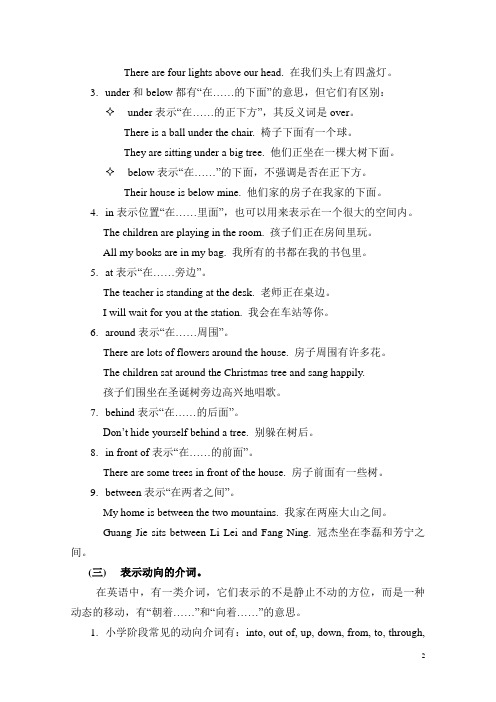
常见介词及用法(一)表示时间的介词1.英语里最常见的时间介词有:at, in, on, before, after和from。
2.at , in和on这三个词都表示时间。
✧at主要指具体的钟点:at half past eight 在八点半✧in一般指某一段时间:in January 在一月份✧on指具体在某一天:on Monday 在星期一3.before和after表示时间的先后顺序。
✧before表示“在……之前”。
You should wash your hands before eating. 吃饭前你应该洗手。
✧after表示“在……之后”。
They often play basketball after dinner. 他们放学后经常打篮球。
4.from作时间介词含有“从……开始”的意思,常和to连用,组成“from…to…”的结构,表示“从……到……”的意思。
We go to school from Monday to Friday. 我们从周一到周五上学。
(二)表示方位的介词,也就是表示位置和地点的介词。
1.小学阶段常见的方位介词有:on, in, at, under, over, above, below, about,around, between等。
2.on, over和above这三个词都有“在……上面”的意思,但它们所表示的方位还是有些不同。
✧on表示两个物体的表面相互接触。
如:There is a book on the desk. 桌上有一本书。
The boy is sleeping on the desk. 那个孩子睡在地上。
✧over表示“在……的正上方”,两个物体表面没有接触。
如:There is a light bulb over my head. 在我头顶上有一个灯泡。
✧above表示两个物体中一个在另一个的上方,如:The plane is flying above the clouds. 飞机上云层上飞行。
时间前的介词用法
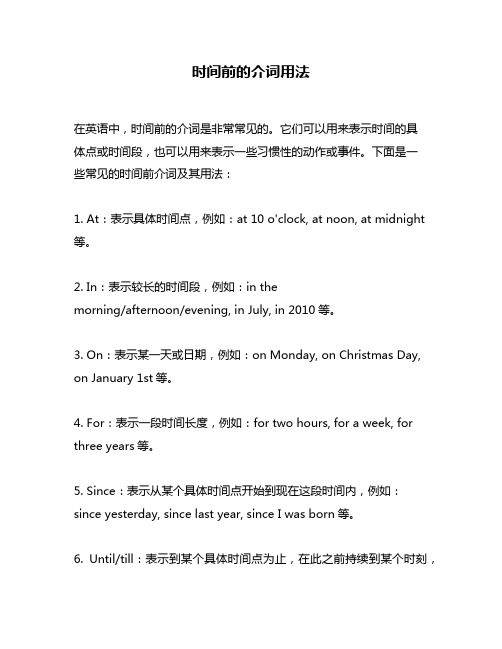
时间前的介词用法
在英语中,时间前的介词是非常常见的。
它们可以用来表示时间的具
体点或时间段,也可以用来表示一些习惯性的动作或事件。
下面是一
些常见的时间前介词及其用法:
1. At:表示具体时间点,例如:at 10 o'clock, at noon, at midnight 等。
2. In:表示较长的时间段,例如:in the
morning/afternoon/evening, in July, in 2010等。
3. On:表示某一天或日期,例如:on Monday, on Christmas Day, on January 1st等。
4. For:表示一段时间长度,例如:for two hours, for a week, for three years等。
5. Since:表示从某个具体时间点开始到现在这段时间内,例如:since yesterday, since last year, since I was born等。
6. Until/till:表示到某个具体时间点为止,在此之前持续到某个时刻,
例如:until/till tomorrow, until/till the end of the month等。
7. By:表示最晚完成某事情的限制时间,例如:by 5 o'clock, by the end of the week等。
8. From/to: 表示一个区间范围内的起始和终止点,例如: from Monday to Friday.
需要注意的是,在使用这些介词时需要注意与其他单词搭配使用时可能产生的语法错误。
同时,在口语交流中也要注意发音和语调以避免产生歧义。
(完整版)英语中介词的用法
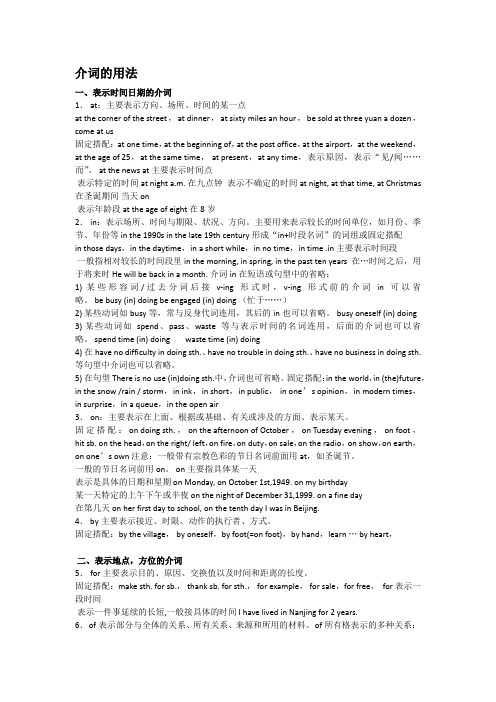
介词的用法一、表示时间日期的介词1.at:主要表示方向、场所、时间的某一点at the corner of the street,at dinner,at sixty miles an hour,be sold at three yuan a dozen,come at us固定搭配:at one time,at the beginning of,at the post office,at the airport,at the weekend,at the age of25,at the same time,at present,at any time,表示原因,表示“见/闻……而”。
at the news at主要表示时间点表示特定的时间at night a.m.在九点钟表示不确定的时间at night,at that time,at Christmas 在圣诞期间当天on表示年龄段at the age of eight在8岁2.in:表示场所、时间与期限、状况、方向。
主要用来表示较长的时间单位,如月份、季节、年份等in the1990s in the late19th century形成“in+时段名词”的词组或固定搭配in those days,in the daytime,in a short while,in no time,in time.in主要表示时间段一般指相对较长的时间段里in the morning,in spring,in the past ten years在…时间之后,用于将来时He will be back in a month.介词in在短语或句型中的省略:1)某些形容词/过去分词后接v-ing形式时,v-ing形式前的介词in可以省略。
be busy(in)doing be engaged(in)doing(忙于……)2)某些动词如busy等,常与反身代词连用,其后的in也可以省略。
英语中时间介词的at, in, on的区别和用法大全
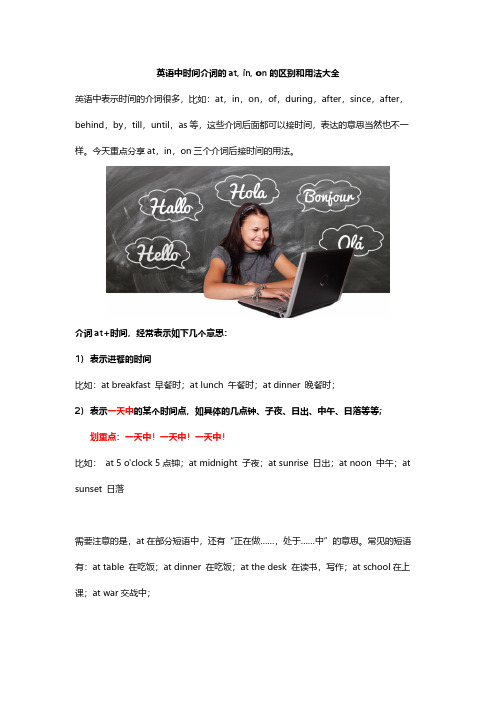
英语中时间介词的at, in, on的区别和用法大全英语中表示时间的介词很多,比如:at,in,on,of,during,after,since,after,behind,by,till,until,as等,这些介词后面都可以接时间,表达的意思当然也不一样。
今天重点分享at,in,on三个介词后接时间的用法。
介词at+时间,经常表示如下几个意思:1)表示进餐的时间比如:at breakfast 早餐时;at lunch 午餐时;at dinner 晚餐时;2)表示一天中的某个时间点,如具体的几点钟、子夜、日出、中午、日落等等;划重点:一天中!一天中!一天中!比如:at 5 o'clock 5点钟;at midnight 子夜;at sunrise 日出;at noon 中午;at sunset 日落需要注意的是,at在部分短语中,还有“正在做……,处于……中”的意思。
常见的短语有:at table 在吃饭;at dinner 在吃饭;at the desk 在读书,写作;at school在上课;at war交战中;介词in+时间,表示一段时间,如上午、下午、周、月、年、季节、世纪等;比如:in 2019 2019年;in the morning 上午;in the afternoon 下午;in two weeks 两周后;in September 在9月;in the 20th century 在20世纪;拓展:in the middle of September 和at the middle of September有什么区别呢?看下面的例句:In the middle of September, I will be back. 我在9月中旬回来(指的是9月10日~20日)At the middle of September, I will be back. 我在9月15日左右回来。
英语时间前面的介词的用法
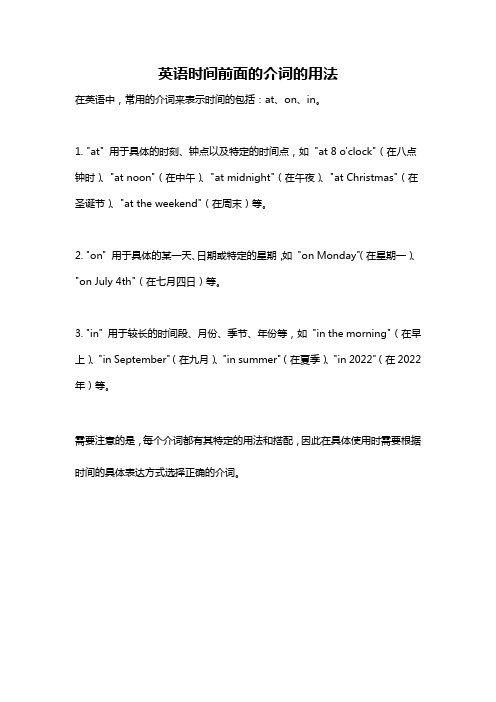
英语时间前面的介词的用法
在英语中,常用的介词来表示时间的包括:at、on、in。
1. "at" 用于具体的时刻、钟点以及特定的时间点,如"at 8 o'clock"(在八点钟时)、"at noon"(在中午)、"at midnight"(在午夜)、"at Christmas"(在圣诞节)、"at the weekend"(在周末)等。
2. "on" 用于具体的某一天、日期或特定的星期,如"on Monday"(在星期一)、"on July 4th"(在七月四日)等。
3. "in" 用于较长的时间段、月份、季节、年份等,如"in the morning"(在早上)、"in September"(在九月)、"in summer"(在夏季)、"in 2022"(在2022年)等。
需要注意的是,每个介词都有其特定的用法和搭配,因此在具体使用时需要根据时间的具体表达方式选择正确的介词。
英语介词的用法归纳
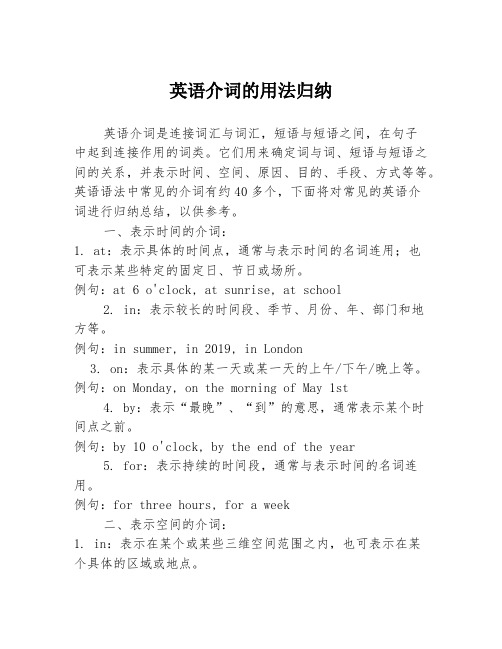
英语介词的用法归纳英语介词是连接词汇与词汇,短语与短语之间,在句子中起到连接作用的词类。
它们用来确定词与词、短语与短语之间的关系,并表示时间、空间、原因、目的、手段、方式等等。
英语语法中常见的介词有约40多个,下面将对常见的英语介词进行归纳总结,以供参考。
一、表示时间的介词:1. at:表示具体的时间点,通常与表示时间的名词连用;也可表示某些特定的固定日、节日或场所。
例句:at 6 o'clock, at sunrise, at school2. in:表示较长的时间段、季节、月份、年、部门和地方等。
例句:in summer, in 2019, in London3. on:表示具体的某一天或某一天的上午/下午/晚上等。
例句:on Monday, on the morning of May 1st4. by:表示“最晚”、“到”的意思,通常表示某个时间点之前。
例句:by 10 o'clock, by the end of the year5. for:表示持续的时间段,通常与表示时间的名词连用。
例句:for three hours, for a week二、表示空间的介词:1. in:表示在某个或某些三维空间范围之内,也可表示在某个具体的区域或地点。
例句:in the room, in the park2. on:表示在某个平面面上,通常用来表示地点。
例句:on the table, on the wall3. at:表示在某个具体的地点或位置。
例句:at the door, at the bus stop4. by:表示“靠近”、“经过”等含义。
例句:by the river, by the window5. between:表示在两个或两个以上的物体或位置之间。
例句:between two mountains, between the buildings6. among:表示在三个或三个以上的物体或位置之间。
小学英语-语法突破:时间介词at,on,in的用法
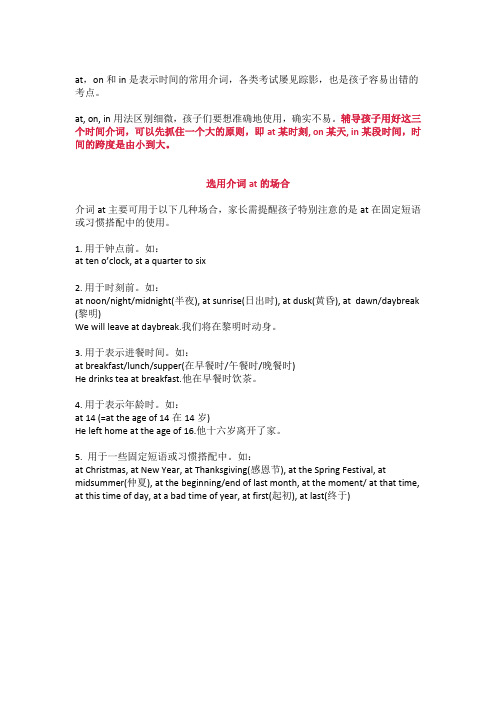
at,on和in是表示时间的常用介词,各类考试屡见踪影,也是孩子容易出错的考点。
at, on, in用法区别细微,孩子们要想准确地使用,确实不易。
辅导孩子用好这三个时间介词,可以先抓住一个大的原则,即at某时刻, on某天, in某段时间,时间的跨度是由小到大。
选用介词at的场合介词at主要可用于以下几种场合,家长需提醒孩子特别注意的是at在固定短语或习惯搭配中的使用。
1. 用于钟点前。
如:at ten o’clock, at a quarter to six2. 用于时刻前。
如:at noon/night/midnight(半夜), at sunrise(日出时), at dusk(黄昏), at dawn/daybreak (黎明)We will leave at daybreak.我们将在黎明时动身。
3. 用于表示进餐时间。
如:at breakfast/lunch/supper(在早餐时/午餐时/晚餐时)He drinks tea at breakfast.他在早餐时饮茶。
4. 用于表示年龄时。
如:at 14 (=at the age of 14在14岁)He left home at the age of 16.他十六岁离开了家。
5. 用于一些固定短语或习惯搭配中。
如:at Christmas, at New Year, at Thanksgiving(感恩节), at the Spring Festival, at midsummer(仲夏), at the beginning/end of last month, at the moment/ at that time, at this time of day, at a bad time of year, at first(起初), at last(终于)选用介词on的场合1.用于星期、日期(包括该天的各部分)前。
如:on Sundays/weekdays, on Monday morning / afternoon / eveningI'm flying home on Sunday afternoon.我星期四下午乘飞机回家。
英语中表示时间的介词

5. I remember Susan left _____a very cold morning of January.
A. in
6. We don’t go to school _____Sundays.
A. on
B. in C. at
D. with
7. Mr. Smith taught English in China ______1997.
on June 1st ,on the morning of July 2 3)morning, afternoon, evening, night, day前有描绘性修饰语 时与on连用;
on that evening, on a cold night, on that day 4)表示周年纪念日;
练习:
1. The story happened ______the evening of August 2.
精确到年月日的介词
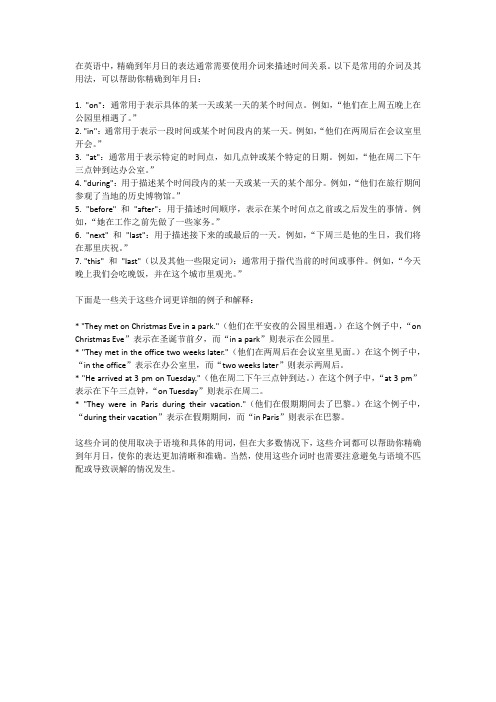
在英语中,精确到年月日的表达通常需要使用介词来描述时间关系。
以下是常用的介词及其用法,可以帮助你精确到年月日:1. "on":通常用于表示具体的某一天或某一天的某个时间点。
例如,“他们在上周五晚上在公园里相遇了。
”2. "in":通常用于表示一段时间或某个时间段内的某一天。
例如,“他们在两周后在会议室里开会。
”3. "at":通常用于表示特定的时间点,如几点钟或某个特定的日期。
例如,“他在周二下午三点钟到达办公室。
”4. "during":用于描述某个时间段内的某一天或某一天的某个部分。
例如,“他们在旅行期间参观了当地的历史博物馆。
”5. "before" 和"after":用于描述时间顺序,表示在某个时间点之前或之后发生的事情。
例如,“她在工作之前先做了一些家务。
”6. "next" 和"last":用于描述接下来的或最后的一天。
例如,“下周三是他的生日,我们将在那里庆祝。
”7. "this" 和"last"(以及其他一些限定词):通常用于指代当前的时间或事件。
例如,“今天晚上我们会吃晚饭,并在这个城市里观光。
”下面是一些关于这些介词更详细的例子和解释:* "They met on Christmas Eve in a park."(他们在平安夜的公园里相遇。
)在这个例子中,“on Christmas Eve”表示在圣诞节前夕,而“in a park”则表示在公园里。
* "They met in the office two weeks later."(他们在两周后在会议室里见面。
)在这个例子中,“in the office”表示在办公室里,而“two weeks later”则表示两周后。
时间介词的用法

时间介词的用法
时间介词的用法
时间介词在英语当中十分常用,能够准确地表达对时间的概念。
大多数的时间介词可以按照时间跨度的长短分为“短态”和“长态”,分别可以用于表示未来或者过去的不同段次。
At短态
At可以用于表示某一固定点时间,如晚上八点,可以写作“At 8:00 p.m.”,以
及半夜零时,可写作“At midnight”。
此外,At还可以用于表示一系列特定的日期,如公元一七六七年的十月五日可写作“At October 5th, 1667”。
In长态
In可以用于表示一段时间内的某一段,如三月份,可以写作“In March”。
同样,可以用于未来的某段时间,如下个星期六,可写作“In next Saturday”,以及比如年底,可以写作“In the end of this year”。
On短态
On可以用来表示某一特定的日子,如星期三可以写作“On Wednesday”,也可以
用来表示日期,比如六月三日可以写作“On June 3rd”。
此外,on还可以表达一
个指定的日子范围,例如在星期一到星期四或者在月底可以用“On Monday-Thursday”或者“At the end of this month”来表达。
At,in以及on都是重要的时间介词,它们可以按照时间跨度的长短分别用于
表示不同段次的未来或者过去。
掌握了这些介词,我们就可以准确表达对时间的概念,使句子表达更丰富,更准确。
表示时间的介词
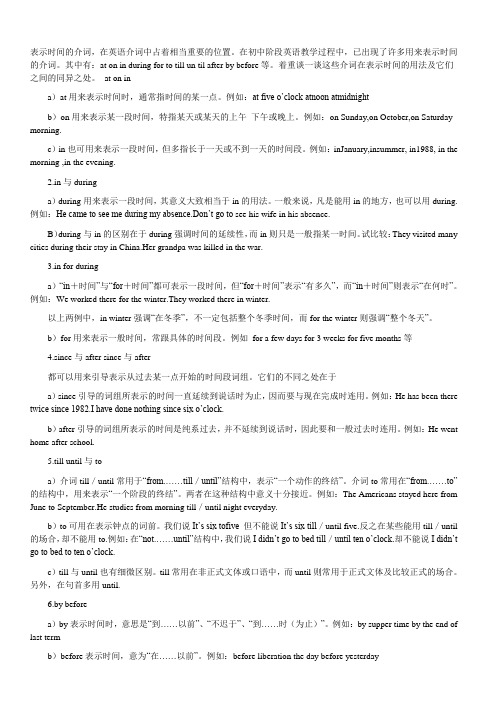
表示时间的介词,在英语介词中占着相当重要的位置。
在初中阶段英语教学过程中,已出现了许多用来表示时间的介词。
其中有:at on in during for to till un til after by before等。
着重谈一谈这些介词在表示时间的用法及它们之间的同异之处。
at on ina)at用来表示时间时,通常指时间的某一点。
例如:at five o’clock atnoon atmidnightb)on用来表示某一段时间,特指某天或某天的上午下午或晚上。
例如:on Sunday,on October,on Saturday morning.c)in也可用来表示一段时间,但多指长于一天或不到一天的时间段。
例如:inJanuary,insummer, in1988, in the morning ,in the evening.2.in与duringa)during用来表示一段时间,其意义大致相当于in的用法。
一般来说,凡是能用in的地方,也可以用during.例如:He came to see me during my absence.Don’t go to see his wife in his absence.B)during与in的区别在于during强调时间的延续性,而in则只是一般指某一时间。
试比较:They visited many cities during their stay in China.Her grandpa was killed in the war.3.in for duringa)“in+时间”与“for+时间”都可表示一段时间,但“for+时间”表示“有多久”,而“in+时间”则表示“在何时”。
例如:We worked there for the winter.They worked there in winter.以上两例中,in winter强调“在冬季”,不一定包括整个冬季时间,而for the winter则强调“整个冬天”。
英语时间介词的用法
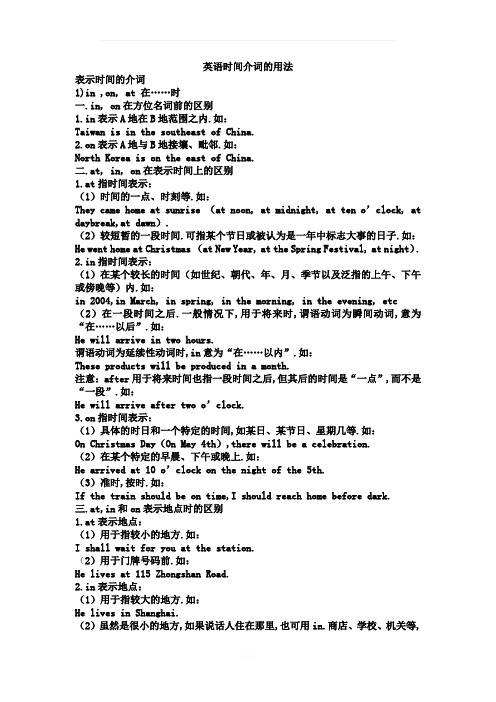
英语时间介词的用法 表示时间的介词 1)in ,on, at 在……时 一.in, on 在方位名词前的区别 1.in 表示 A 地在 B 地范围之内.如: Taiwan is in the southeast of China. 2.on 表示 A 地与 B 地接壤、毗邻.如: North Korea is on the east of China. 二.at, in, on 在表示时间上的区别 1.at 指时间表示: (1)时间的一点、时刻等.如: They came home at sunrise (at noon, at midnight, at ten o’clock, at daybreak,at dawn). (2)较短暂的一段时间.可指某个节日或被认为是一年中标志大事的日子.如: He went home at Christmas (at New Year, at the Spring Festival, at night). 2.in 指时间表示: (1)在某个较长的时间(如世纪、朝代、年、月、季节以及泛指的上午、下午 或傍晚等)内.如: in 2004,in March, in spring, in the morning, in the evening, etc (2)在一段时间之后.一般情况下,用于将来时,谓语动词为瞬间动词,意为 “在……以后”.如: He will arrive in two hours. 谓语动词为延续性动词时,in 意为“在……以内”.如: These products will be produced in a month. 注意:after 用于将来时间也指一段时间之后,但其后的时间是“一点”,而不是 “一段”.如: He will arrive after two o’clock. 3.on 指时间表示: (1)具体的时日和一个特定的时间,如某日、某节日、星期几等.如: On Christmas Day(On May 4th),there will be a celebration. (2)在某个特定的早晨、下午或晚上.如: He arrived at 10 o’clock on the night of the 5th. (3)准时,按时.如: If the train should be on time,I should reach home before dark. 三.at,in 和 on 表示地点时的区别 1.at 表示地点: (1)用于指较小的地方.如: I shall wait for you at the station. (2)用于门牌号码前.如: He lives at 115 Zhongshan Road. 2.in 表示地点: (1)用于指较大的地方.如: He lives in Shanghai. (2)虽然是很小的地方,如果说话人住在那里,也可用 in.商店、学校、机关等,
(完整版)英语中介词的用法
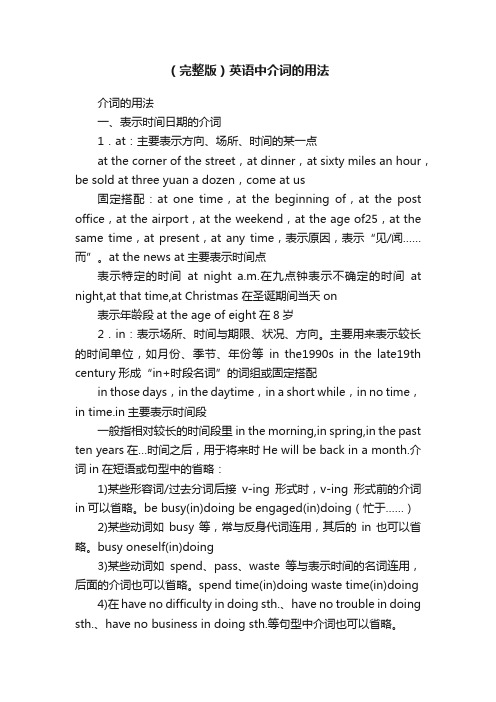
(完整版)英语中介词的用法介词的用法一、表示时间日期的介词1.at:主要表示方向、场所、时间的某一点at the corner of the street,at dinner,at sixty miles an hour,be sold at three yuan a dozen,come at us固定搭配:at one time,at the beginning of,at the post office,at the airport,at the weekend,at the age of25,at the same time,at present,at any time,表示原因,表示“见/闻……而”。
at the news at主要表示时间点表示特定的时间at night a.m.在九点钟表示不确定的时间at night,at that time,at Christmas 在圣诞期间当天on表示年龄段at the age of eight在8岁2.in:表示场所、时间与期限、状况、方向。
主要用来表示较长的时间单位,如月份、季节、年份等in the1990s in the late19th century形成“in+时段名词”的词组或固定搭配in those days,in the daytime,in a short while,in no time,in time.in主要表示时间段一般指相对较长的时间段里in the morning,in spring,in the past ten years在…时间之后,用于将来时He will be back in a month.介词in在短语或句型中的省略:1)某些形容词/过去分词后接v-ing形式时,v-ing形式前的介词in可以省略。
be busy(in)doing be engaged(in)doing(忙于……)2)某些动词如busy等,常与反身代词连用,其后的in也可以省略。
小学英语介词at-in与on在时间方面的用法

小学英语介词at,in与on在时间方面的用法小学英语介词at,in与on在时间方面的用法at表示时间的一点;in表示一个时期;on表示特殊日子,如:He goes to school at seven o’clock in the morning.他早晨七点上学。
Can you finish the work in two days.你能在两天内完成这个工作吗?Linda was born on the second of May.琳达五月二日出生。
1. at后常接几点几分,天明,中午,日出,日落,开始等。
如:at five o’clock (五点),at down (黎明),at daybreak (天亮),at sunrise (日出),at noon (中午),at sunset (日落),at midnight (半夜),at the beginning of the month (月初),at that time (那时),at that moment (那会儿),at this time of day (在一天的这个时候)。
2. in后常接年,月,日期,上午,下午,晚上,白天,季节,世纪等。
如:in 2006(2006年),in May,2004 (2004年五月),in the morning (早晨/上午),in the afternoon (下午),in the evening (晚上),in the night (夜晚),in the daytime (白天),in the 21st century (21世纪),in three days (weeks/month)三天(周/个月),in a week (一周),in spring (春季)。
3. on后常接某日,星期几,某日或某周日的朝夕,节日等。
如:on Sunday (星期日),on a warm morning in April (四月的一个温暖的上午),on a December night (12月的一个夜晚),on that afternoon (那天下午),on the following night (下一个晚上),on Christmas afternoon (圣诞节下午),on October 1,1949 (1949年10月1日),on New Year’s Day (新年),on New Year’s Eve (除夕),on the morning of the 15th (15日的早上)等。
常见介词的用法
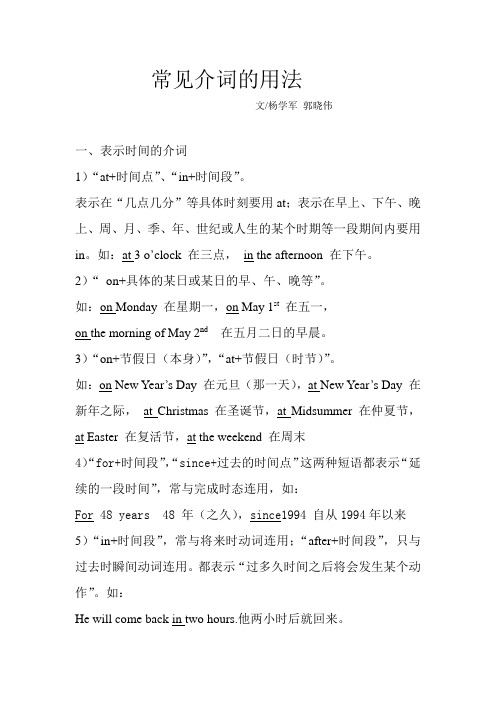
常见介词的用法文/杨学军郭晓伟一、表示时间的介词1)“at+时间点”、“in+时间段”。
表示在“几点几分”等具体时刻要用at;表示在早上、下午、晚上、周、月、季、年、世纪或人生的某个时期等一段期间内要用in。
如:at 3 o’clock 在三点,in the afternoon 在下午。
2)“on+具体的某日或某日的早、午、晚等”。
如:on Monday 在星期一,on May 1st在五一,on the morning of May 2nd在五月二日的早晨。
3)“on+节假日(本身)”,“at+节假日(时节)”。
如:on New Year’s Day 在元旦(那一天),at New Year’s Day 在新年之际,at Christmas 在圣诞节,at Midsummer 在仲夏节,at Easter 在复活节,at the weekend 在周末4)“for+时间段”,“since+过去的时间点”这两种短语都表示“延续的一段时间”,常与完成时态连用,如:For 48 years 48 年(之久),since1994 自从1994年以来5)“in+时间段”,常与将来时动词连用;“after+时间段”,只与过去时瞬间动词连用。
都表示“过多久时间之后将会发生某个动作”。
如:He will come back in two hours.他两小时后就回来。
He came back after two hours.俩个小时后回来了。
二、表示地点、范围、趋向的介词。
1)“at+点”,“on+面”,“in+体”。
如:He stood at the door with a picture on it,looking in through a hole in the door.一个陌生人站在上面贴有一张画的门那儿,正从门上的孔洞里向里观望。
2)“across+表面”,“through+空间”。
如:The river runs through our city,across the firlds and then into the sea.那条河穿过我们城市,流经田野,然后汇入大海。
- 1、下载文档前请自行甄别文档内容的完整性,平台不提供额外的编辑、内容补充、找答案等附加服务。
- 2、"仅部分预览"的文档,不可在线预览部分如存在完整性等问题,可反馈申请退款(可完整预览的文档不适用该条件!)。
- 3、如文档侵犯您的权益,请联系客服反馈,我们会尽快为您处理(人工客服工作时间:9:00-18:30)。
英语介词中时间介词的用法
英语介词一直是让学生很头疼的一个语法点,中文说道“在某某时间”时只用一个介词“在”就可以了,而英文会有at、on、in等等不同介词,下面是一个英文时间介词的大致使用规律分类。
早、午、晚要用in 例:in the morning 在早上
in the afternoon 在下午
in the evening 在晚上
in the day 在白天
at黎明、午、夜
例: at dawn, at daybreak 在黎明时候
at noon 在中午
at night 在夜间
at midnight 在午夜
在具体的点时间和周末,也用in
at six o'clock 在6点钟
at ten thirty a.m. 在上午10点30分
seven to five 5点差7分(半小时以上)
at the weekend 在周末
年、月、年月、季节、周
即在“来年”,在“某月”,在“某年某月” (但在某年某月某日则用on),在四季,在第几周等都要用in。
in December 1986 1986年12月
in July l983 1983年7月
in spring 在春季
in the third week 在第三周
在周几前用on
on Monday
on Sunday
周几和早、中、晚连用是是遵循“就近原则”(就是以第一个词为主)用on on Monday morning
on Sunday evening。
